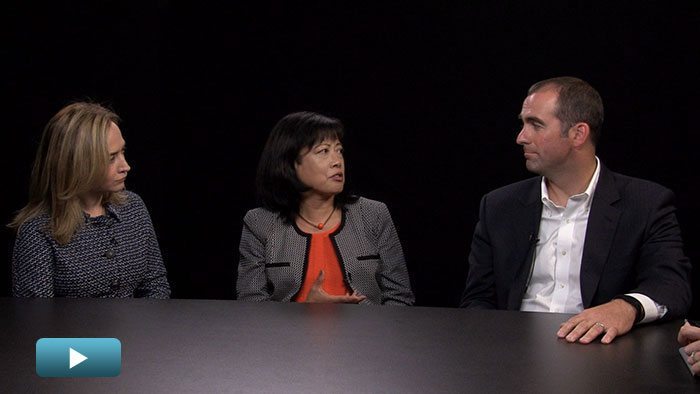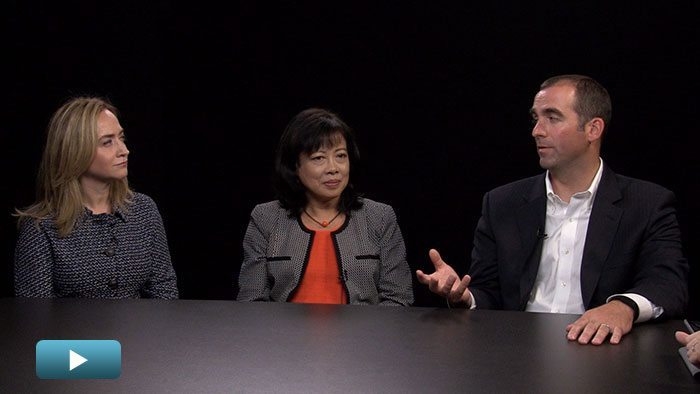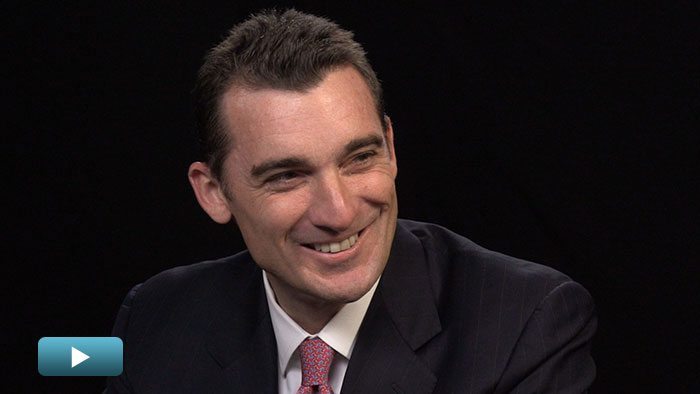New Risks in Core Investing
Increased competition for core real estate assets has made valuations spike, creating risk in an otherwise healthy sector of the market. Three professionals from PREI, NEPC, and formerly of the Connecticut State Retirement and Trust Funds break down the risks versus the rewards of investing in the asset class.
Transcript Download Transcript
New Risks in Core Investing
The Evolution of Core
Zoe Hughes, PrivcapRE: I’m joined here today by Cathy Marcus, Global Chief Operating Officer for Prudential Real Estate Investors; Cherie Santos-Wuest, Principal Investment Officer for Real Estate at the Connecticut State Retirement and Trust Funds; and Sean Ruhmann, Director Of Real Assets Research at NEPC. Thank you so much for joining me today.
Unison: Thank you.
Hughes: I think it’s fair to say there have been unprecedented capital flows into looking for and flowing into U.S. core real estate. Whether that’s from domestic investors, foreign investors or even new entrants into the space, we’ve seen eye-popping valuations, with many of the major markets actually going past their 2007 peak. This raises a very fundamental question: how do we actually execute on core strategies today without a touch being too risky? I’d love to get your thoughts. Core has been a fantastic performer, but how do we actually view these rising valuations? Cathy, let me bring you in here. Are you worried about the valuations you’re seeing within some of the core real estate?
Cathy Marcus, Prudential Real Estate Investors: I’m not worried about valuations within core real estate as long as your expectations are set appropriately, which is where the valuations are with maybe a little bit of growth with income that’s probably where they’re going to be. You shouldn’t expect the same sort of run-up that we’ve had. If you look at markers like spreads to treasuries or spreads to corporate bonds, you feel pretty good about where the valuations are despite the fact that cap rates are pretty low. We are above or at peak in some markets. But, overall, when you look at a lot of the metrics and the fundamentals from a growth-expectation perspective, from a supply perspective, and you look at leading indicators, you feel pretty good about growth over the next couple years. As long as your mind is set in terms of realistic expectations for what core will or how it may perform over the next couple years versus looking back three or four years, I think people should feel pretty comfortable.
Hughes: Cherie, as an investor, does it worry you about the pricing you’re seeing, particularly some of the cap rates we’re seeing for certain deals?
Cherie Santos-Wuest, formerly of Connecticut State Retirement and Trust Funds: We execute our core strategy through two different venues. One is through open-ended core funds, the other through our two separate accounts, where we’re actually purchasing the properties for using third-party managers. But being very involved in all the aspects of the purchase as well as financing of these properties. On the open-ended core funds, I am not as concerned because even though some of my managers are actually purchasing with three handles on the cap rates, I know it’s a much larger, blended diversified portfolio. Some of the assets in those funds have been sitting there for 15 years and are picking up a lot of the slack from 3% going in cap rates of purchases today by appreciation from earlier cap, because they’ve been holding the assets for so long at such a low basis. Overall, the investments within those portfolios are a bit less—that doesn’t keep me up at night as much. Where I’m having some issues would be in our separate accounts. I have had a lot of discussions about this with my managers, who are frustrated because they simply cannot execute the strategy because of the pricing in the markets.
Hughes: Sean, are you sensing among the managed community that there is that frustration in terms of perhaps being able to get capital out and the competition in the market?
Sean Ruhmann, NEPC: Certainly, there is lots of capital in the space and that makes it harder to find good deals. We are certainly neutral on core real estate today in the U.S. That definitely means we worry about it. On a relative basis, there are a lot of positive things, as you mentioned. However, on an absolute basis, that’s where we start to get nervous. Yields are generally pretty low, relative to historical yields. You look at REITs—REITs are trading in very high FFO multiples, relative to historic basis. That certainly makes us nervous, but then you look at other asset classes and everything is expensive.
Hughes: I have been told there is no such thing as an off-market core deal. Do you find that? Is that the case today? Is there any such thing as an off-market core deal?
Marcus: I don’t even know how people define off-market anymore. I don’t know if you guys experience this, but about two years ago, brokers started always stamping “Draft” on the OMs so that they could say it was off-market, because an official OM had not been issued. Do I think there are a lot of sellers out there who are not exposing their assets broadly? No, but I will say even just this week, I heard of two deals where they were doing a very limited marketing. Whether they really were or they were just trying to make me feel special, I don’t know what that was. But people always have some reason—they have a tax reason—it’s a closed–end fund with this last asset. There is often some reason why they want to do a more limited marketing, but you have to wonder truly why anyone would not expose—
Santos-Wuest: I’m sorry, that’s such a conundrum. I don’t think there is such a thing as an off-market core deal unless you’re building it yourself. We do have some core managers who have absorbed development platforms and are building the core. That’s the only off-market development core I can think of, unless you’ve seen something else.
Ruhmann: No.
Santos-Wuest: It’s like an urban myth, an urban legend.
Ruhmann: There are previously marketed deals that may be off-market now, but yeah, I wouldn’t expect that there are a lot of truly off-market core deals.
Hughes: So you’re seeing core move into the alternative real estate space?
Marcus: A little bit. We did our first investment for preset in self-storage in 2005. That was a while ago. At the time, the way we looked at self-storage was as a proxy for multi-family. We felt that it had a lot of the same risk characteristics as multi-family. But, at that point, there was about a 200-basis point spread. There is still a spread, but it’s certainly not 200 basis points now. Self-storage is so much more institutional than it had been. It’s much more accepted as a core from the way the income—it’s very typical.
Santos-Wuest: In certain markets, obviously, in limited markets.
Marcus: In certain markets, exactly. Again, you have a lot of the characteristics, a very high percentage of your income, of your total return comes from income, very low capital that’s required. I think that’s a good example. We also invested in data centers in preset and, again, to Sean’s point, in NCREIF they roll that into industrial. So it is hard to say because, if you look at the Odyssey Index, it’s still about 95% in the four major food groups. That’s been about the same for a really long time, but I think it is because certain things like data centers get rolled into industrial. And you don’t know exactly what’s in all of those characterizations. Of course, retail—there are so many different kinds of retail that you can do under the umbrella.
Hughes: Is that why we’re seeing such great growth, particularly with some of the secondary markets? I’ll deem them secondary markets, but really high–growth markets, obviously STEM-fueled or tech–fueled—someone described it as “ex-urban core” almost. Cherie, how do you view the opportunities geographically?
Santos-Wuest: From a geographical standpoint, I would expect core to be located in the primary markets. These would be the seven to eight different gateway cities in the U.S. That said, and these have the kind of locational qualities that reflect a high barrier to entry and high demand. Usually, there is a correspondent high population and job-growth factor with it.
Hughes: Sean, if we just looked at perhaps global core, there are some U.S. investors who are looking at core overseas. Do the yields make sense when you look at a London, a Tokyo or a Paris?
Ruhmann: We tend to think not, in general. If you think about what makes for a very good core investment, it’s an attractive going-in yield and ideally high NOI growth. When you go outside the U.S. to some of those markets, the going–in yield doesn’t look particularly great. Then, in certain areas, you have demographic concerns. A lot of our investors tend to focus more in the U.S. just because of that.
Marcus: I would say one thing people really focus on is leverage. That was a big lesson in the last downturn—not just leverage, but is it recourse or non-recourse? Is it fixed or floating? What do your maturities look like? There is still a tremendous amount of focus on debt. And I do feel that people like Cherie, that is a big part of the evaluating manager—not just exactly what the leverage situation is, but how people think about leverage and whether it’s top of mind and they understand the risks there.
Hughes: Sean, is it a case of asking more questions today in order to get to that? How do we really know how much risk you’re taking in the market?
Ruhmann: It’s a hard thing to truly get to. I’m an engineer by early schooling, so by definition I like to collect lots of data. And collecting uniform data is hard to do. It’s not an easy thing. You’d like to start to underpin that risk analysis based on lots of data collection to understand NOI, rent growth, occupancy trends across managers and digging down into particular MSAs, but it becomes harder to do.
Hughes: Surely, it becomes more qualitative rather than quantitative. There is a very subjective element in it today, I would argue.
Ruhmann: You have to overlay that. You just can’t collect a whole bunch of data, although I’d like to do that, and come up with an answer. You have to overlay on top of that, trying to understand the qualitative aspects of the portfolios and trying to get a sense of which managers are picking assets in spots that you think will have relatively outsized NOI growth. Going back to an earlier question of core—what defines it, where is it? That does evolve over time. If you went back 30 or 40 years and looked at what the major core assets were in cities, those neighborhoods have changed over time. San Francisco is probably a good example, if you look at California Street. At one point, that was part of the Wall Street of the west, or ran into it. Today, the center of that city is evolved a bit. Similarly, in Boston, if you went back, when our firm [was] founded 30 years ago, we were based in Kendall Square because that was a very cheap place to be. Were priced out of Kendall Square and moved into State Street in Boston because that was going to be cheaper. These markets evolve over time and it’s trying to find that manager that can pick spots that, again, are going to have very stable dependable income but higher growth rates and rent. That’s where it becomes more hard.
Santos-Wuest: Or a longer runway on growth rates and rents is also another consideration, right?
Ruhmann: Yeah, absolutely.
Hughes: Where are we in the cycle? I know it’s a question that people hate in many ways. But where are we in the cycle, do you think?
Santos-Wuest: To use the Ken Rosen Clock, apartments would be about 9:30 to 10:00, and industrial and office would be somewhere in the 6:00 range. I don’t know. That’s kind of the way I view this…in a spatial sense, it depends on the sector and depends on the geography.
Marcus: In our cycle watch, we’re at the end of recovery, but before expansion.
Ruhmann: Yeah, we looked for a lot of the same triggers, some other specific things—certainly spreads to treasuries—that if you look historically and not that history will always repeat itself, but spread to treasuries, when that collapses, that’s been a great foreshadower for problems ahead for core real estate returns. New construction—you mentioned the architectural billing index. Things like that and another at least historically great predictor of future NOI growth has been new construction as a percentage of in–place construction. Are you getting to a point where there should be a lot of excess space that will drive down rents and occupancies? Do you worry about the spread relative to treasuries, that that unwinds and it wipes out returns?








